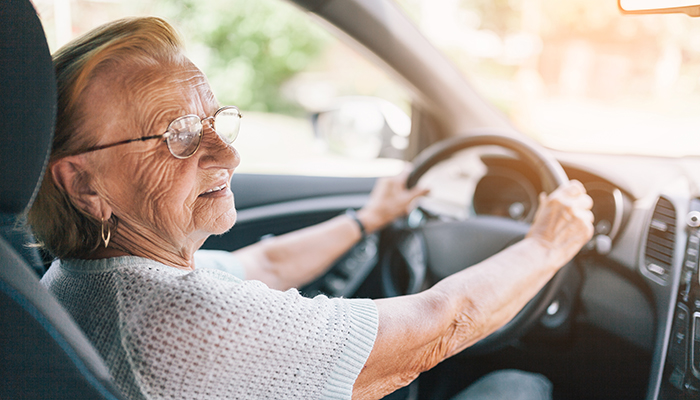Learn more at AgingWellMetroDC.com
Should Dad still be driving?
 Did a recent visit with your parents reveal new dents in the car? Did a drive together result in a hair-raising ride? If so, it could be that it’s time to reassess your loved one’s ability to drive safely. Safe driving is not dictated by age. Plenty of middle-aged people are terrible drivers. And there are people in their 90s who are still superb drivers. But age, undeniably, makes driving more challenging.
Did a recent visit with your parents reveal new dents in the car? Did a drive together result in a hair-raising ride? If so, it could be that it’s time to reassess your loved one’s ability to drive safely. Safe driving is not dictated by age. Plenty of middle-aged people are terrible drivers. And there are people in their 90s who are still superb drivers. But age, undeniably, makes driving more challenging.
Signs that a problem may be brewing
- Two or more tickets in the past two years. Running a stop sign, going the wrong way on a one-way street, and poor parking are the most common.
- Two or more accidents in the past two years. Older adults have more accidents involving left-hand turns. Even little “fender benders” are noteworthy. Parking lot crunches and sideswipes, for instance, indicate a driver error.
- Dementia. Alzheimer’s and other forms of dementia impair judgment and often depth or spatial perception. If your loved one is in the early stages, it may or may not be safe to drive for a while longer. Talk with the doctor.
- Medications. Many drugs—prescription and over-the-counter—slow reflexes and thinking processes. Not good for driving.
- Poor vision and hearing. Common problems include not seeing pedestrians, stop signs, or lane lines. Night vision declines for everyone starting in middle age, but gets worse as we get older.
- Stiffness in the neck and shoulders. Lack of flexibility can result in not turning one’s head around completely when backing up, changing lanes, or merging with traffic.
To get an assessment
- Download the Drivers 65 Plus self-assessment brochure from the American Automobile Association (exchange.aaa.com). This is a 15-question, self-rating survey your loved one can complete at home. It includes tips for addressing identified problems.
- Talk privately with the doctor and see if they will recommend an evaluation by an occupational therapist to address any underlying medical issues.
- Consider a driving skills evaluation. Driving schools have certified evaluators. You can also contact the American Automobile Association for a local list of evaluators.
Help Mom be a safer driver

Driving is not an all-or-nothing proposition. If you do bring up driving concerns, tread lightly. And be sure to emphasize your desire to help your loved one continue to drive. Driving safety can be accomplished with a collection of small modifications.
A Mature Driver course. The American Automobile Association and the American Association of Retired Persons each offer courses that take just a few hours. They are filled with useful tips for older adults. You can even find courses online. If you are looking for an incentive, check with your relative’s car insurance. They will likely discount premiums for those who take an approved course.
Changes to the car. Have seats and mirrors adjusted so that your loved one has maximum visibility. Reduce blind spots by adding wide-angle mirrors. Keep wipers fresh for clear vision in the rain. Check brakes regularly. And make sure the tires are properly inflated and have enough tread for good traction and stopping.
Flexibility exercises. There are stretches that can be done to improve the range of turning of the head. This is vital for safely backing up, changing lanes, and getting on the freeway.
Prudent driving habits. If glare and night vision are a problem, consider not driving from twilight on. Only travel surface streets; avoid the freeway when possible. Run errands midday when traffic is lighter. Remember that three right turns can get you where a left turn does and is immensely safer, especially if there is no left-turn light. Reduce distractions: Halt conversations and turn off the radio when driving conditions are complicated. This allows for maximum response time even if reflexes are slow.
Reduced driving ability does not mean your loved one needs to give up driving altogether. Slight modifications such as these can quickly increase safety and extend your relative’s ability to drive well for years.
Return to topAlternatives to driving
Most older adults outlive their ability to drive safely by seven to ten years. This means they need to develop alternate ways of getting around. Here is a list to help you strategize:
- Friends and family. This is by far the most common.
- Public transportation. Consider riding the bus together to a fun event. Make the bus ride part of the adventure. See if there’s a “buddy program” for new riders. If your relative has disabilities, check out the company’s paratransit program. This allows for door-to-door service from your loved one’s home to their destination.
- Volunteer driver programs. Many churches and senior centers have volunteers who can be scheduled a few days in advance to take your relative from one place to another.
- Ride-sharing apps. Lyft and Uber are becoming very sensitive to the needs of older adults. They have special certifications for senior-friendly drivers. They are also exploring options that don’t require a smartphone. GoGoGrandparent.com offers a service that bridges between the app and your loved one on a regular phone. And senior-oriented phones, such as Lively, are also exploring programs to make ride sharing easier.
- Delivery services. The pandemic has resulted in many businesses adding online ordering with delivery to your door. This is a great way for your loved one to get the things they need without having to drive.
- Special service vans. Medical or cancer treatment centers often have a van service. Take a shuttle to the airport. Senior centers are putting together cultural outings for evening and faraway events. Board the van and leave the driving and parking to someone else!
Find out now what’s available. Check out ridesinsight.org or call 855-607-4337 (toll-free, nationwide) to find local driving alternatives.
Contact us at 301-593-5285
